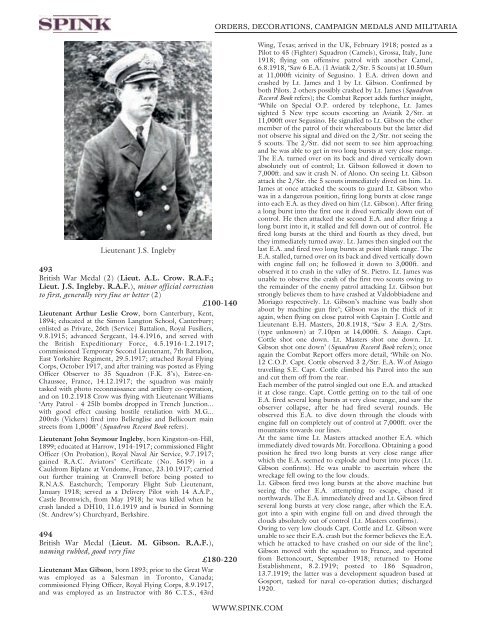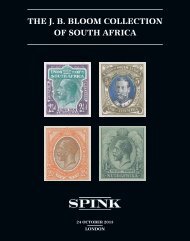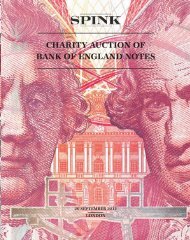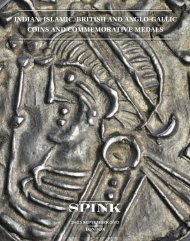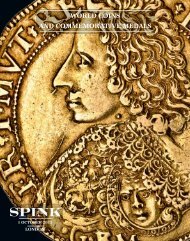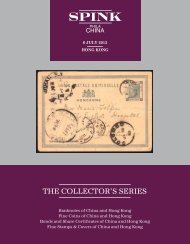orders, decorations, campaign medals and militaria - Spink
orders, decorations, campaign medals and militaria - Spink
orders, decorations, campaign medals and militaria - Spink
Create successful ePaper yourself
Turn your PDF publications into a flip-book with our unique Google optimized e-Paper software.
Lieutenant J.S. Ingleby<br />
493<br />
British War Medal (2) (Lieut. A.L. Crow. R.A.F.;<br />
Lieut. J.S. Ingleby. R.A.F.), minor official correction<br />
to first, generally very fine or better (2)<br />
£100-140<br />
Lieutenant Arthur Leslie Crow, born Canterbury, Kent,<br />
1894; educated at the Simon Langton School, Canterbury;<br />
enlisted as Private, 26th (Service) Battalion, Royal Fusiliers,<br />
9.8.1915; advanced Sergeant, 14.4.1916, <strong>and</strong> served with<br />
the British Expeditionary Force, 4.5.1916-1.2.1917;<br />
commissioned Temporary Second Lieutenant, 7th Battalion,<br />
East Yorkshire Regiment, 29.5.1917; attached Royal Flying<br />
Corps, October 1917, <strong>and</strong> after training was posted as Flying<br />
Officer Observer to 35 Squadron (F.K. 8’s), Estree-en-<br />
Chaussee, France, 14.12.1917; the squadron was mainly<br />
tasked with photo reconnaissance <strong>and</strong> artillery co-operation,<br />
<strong>and</strong> on 10.2.1918 Crow was flying with Lieutenant Williams<br />
‘Arty Patrol - 4 25lb bombs dropped in Trench Junction...<br />
with good effect causing hostile retaliation with M.G...<br />
200rds (Vickers) fired into Bellenglise <strong>and</strong> Bellicourt main<br />
streets from 1,000ft’ (Squadron Record Book refers).<br />
Lieutenant John Seymour Ingleby, born Kingston-on-Hill,<br />
1899; educated at Harrow, 1914-1917; commissioned Flight<br />
Officer (On Probation), Royal Naval Air Service, 9.7.1917;<br />
gained R.A.C. Aviators’ Certificate (No. 5619) in a<br />
Cauldrom Biplane at Vendome, France, 23.10.1917; carried<br />
out further training at Cranwell before being posted to<br />
R.N.A.S. Eastchurch; Temporary Flight Sub Lieutenant,<br />
January 1918; served as a Delivery Pilot with 14 A.A.P.,<br />
Castle Bromwich, from May 1918; he was killed when he<br />
crash l<strong>and</strong>ed a DH10, 11.6.1919 <strong>and</strong> is buried in Sonning<br />
(St. Andrew’s) Churchyard, Berkshire.<br />
494<br />
British War Medal (Lieut. M. Gibson. R.A.F.),<br />
naming rubbed, good very fine<br />
£180-220<br />
Lieutenant Max Gibson, born 1893; prior to the Great War<br />
was employed as a Salesman in Toronto, Canada;<br />
commissioned Flying Officer, Royal Flying Corps, 8.9.1917,<br />
<strong>and</strong> was employed as an Instructor with 86 C.T.S., 43rd<br />
<strong>orders</strong>, deCoratioNs, CampaigN medaLs aNd miLitaria<br />
WWW.spiNK.Com<br />
Wing, Texas; arrived in the UK, February 1918; posted as a<br />
Pilot to 45 (Fighter) Squadron (Camels), Grossa, Italy, June<br />
1918; flying on offensive patrol with another Camel,<br />
6.8.1918, ‘Saw 6 E.A. (1 Aviatik 2/Str. 5 Scouts) at 10.50am<br />
at 11,000ft vicinity of Segusino. 1 E.A. driven down <strong>and</strong><br />
crashed by Lt. James <strong>and</strong> 1 by Lt. Gibson. Confirmed by<br />
both Pilots. 2 others possibly crashed by Lt. James (Squadron<br />
Record Book refers); the Combat Report adds further insight,<br />
‘While on Special O.P. ordered by telephone, Lt. James<br />
sighted 5 New type scouts escorting an Aviatik 2/Str. at<br />
11,000ft over Segusino. He signalled to Lt. Gibson the other<br />
member of the patrol of their whereabouts but the latter did<br />
not observe his signal <strong>and</strong> dived on the 2/Str. not seeing the<br />
5 scouts. The 2/Str. did not seem to see him approaching<br />
<strong>and</strong> he was able to get in two long bursts at very close range.<br />
The E.A. turned over on its back <strong>and</strong> dived vertically down<br />
absolutely out of control; Lt. Gibson followed it down to<br />
7,000ft. <strong>and</strong> saw it crash N. of Alono. On seeing Lt. Gibson<br />
attack the 2/Str. the 5 scouts immediately dived on him. Lt.<br />
James at once attacked the scouts to guard Lt. Gibson who<br />
was in a dangerous position, firing long bursts at close range<br />
into each E.A. as they dived on him (Lt. Gibson). After firing<br />
a long burst into the first one it dived vertically down out of<br />
control. He then attacked the second E.A. <strong>and</strong> after firing a<br />
long burst into it, it stalled <strong>and</strong> fell down out of control. He<br />
fired long bursts at the third <strong>and</strong> fourth as they dived, but<br />
they immediately turned away. Lt. James then singled out the<br />
last E.A. <strong>and</strong> fired two long bursts at point blank range. The<br />
E.A. stalled, turned over on its back <strong>and</strong> dived vertically down<br />
with engine full on; he followed it down to 3,000ft. <strong>and</strong><br />
observed it to crash in the valley of St. Pietro. Lt. James was<br />
unable to observe the crash of the first two scouts owing to<br />
the remainder of the enemy patrol attacking Lt. Gibson but<br />
strongly believes them to have crashed at Valdobbiadene <strong>and</strong><br />
Moriago respectively. Lt. Gibson’s machine was badly shot<br />
about by machine gun fire’; Gibson was in the thick of it<br />
again, when flying on close patrol with Captain J. Cottle <strong>and</strong><br />
Lieutenant E.H. Masters, 20.8.1918, ‘Saw 3 E.A. 2/Strs.<br />
(type unknown) at 7.10pm at 14,000ft. S. Asiago. Capt.<br />
Cottle shot one down. Lt. Masters shot one down. Lt.<br />
Gibson shot one down’ (Squadron Record Book refers); once<br />
again the Combat Report offers more detail, ‘While on No.<br />
12 C.O.P. Capt. Cottle observed 3 2/Str. E.A. W.of Asiago<br />
travelling S.E. Capt. Cottle climbed his Patrol into the sun<br />
<strong>and</strong> cut them off from the rear.<br />
Each member of the patrol singled out one E.A. <strong>and</strong> attacked<br />
it at close range. Capt. Cottle getting on to the tail of one<br />
E.A. fired several long bursts at very close range, <strong>and</strong> saw the<br />
observer collapse, after he had fired several rounds. He<br />
observed this E.A. to dive down through the clouds with<br />
engine full on completely out of control at 7,000ft. over the<br />
mountains towards our lines.<br />
At the same time Lt. Masters attacked another E.A. which<br />
immediately dived towards Mt. Forcellona. Obtaining a good<br />
position he fired two long bursts at very close range after<br />
which the E.A. seemed to explode <strong>and</strong> burst into pieces (Lt.<br />
Gibson confirms). He was unable to ascertain where the<br />
wreckage fell owing to the low clouds.<br />
Lt. Gibson fired two long bursts at the above machine but<br />
seeing the other E.A. attempting to escape, chased it<br />
northwards. The E.A. immediately dived <strong>and</strong> Lt. Gibson fired<br />
several long bursts at very close range, after which the E.A.<br />
got into a spin with engine full on <strong>and</strong> dived through the<br />
clouds absolutely out of control (Lt. Masters confirms).<br />
Owing to very low clouds Capt. Cottle <strong>and</strong> Lt. Gibson were<br />
unable to see their E.A. crash but the former believes the E.A.<br />
which he attacked to have crashed on our side of the line’;<br />
Gibson moved with the squadron to France, <strong>and</strong> operated<br />
from Bettoncourt, September 1918; returned to Home<br />
Establishment, 8.2.1919; posted to 186 Squadron,<br />
13.7.1919; the latter was a development squadron based at<br />
Gosport, tasked for naval co-operation duties; discharged<br />
1920.


